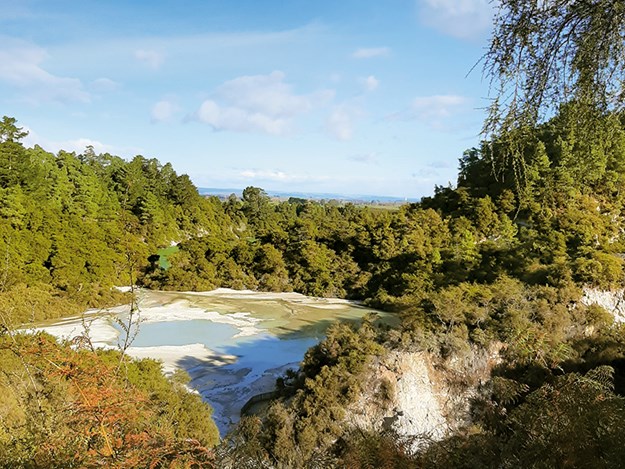 |
The geothermal area of Wai-O-Tapu |
It was raining and cold when Malcolm and I arrived in Rotorua. Luckily, we timed it right and got a spot in the motorhome and campervan parking area beside the Government Gardens, just a few minutes’ walk from the town centre, and right outside the Polynesian Spa. The sign in the parking area welcomed us, as self-contained vehicle owners, and encouraged us to explore the area, a place they called New Zealand’s Coolest Hot Spot.
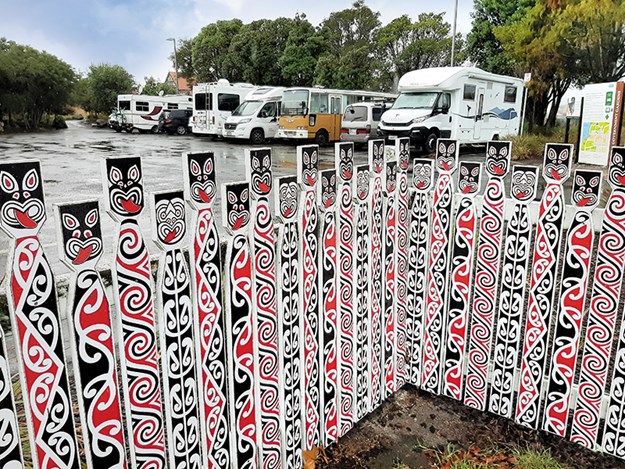 |
Freedom camping at Government Gardens |
Mineral Hot Springs
Feeling the need to warm up, we headed straight to the Polynesian Spa for a soak in the warming and therapeutic water. Known as the country’s original geothermal bathing facility, the Polynesian Spa has various pool options, catering for families and those who want a child-free experience. There’s also a Deluxe Spa, which boasts extras like heated recliners, and an area of small private pools. Two springs feed the spa’s 28 mineral pools and visitors can try the slightly acidic water, which relieves aches and pains, while the alkaline Rachel Spring soothes the skin. The rain eased off as we relaxed in the hot pools, watching steam rise over the lake.
Sulphur and Steam
You can’t go far in Rotorua without experiencing the rotten-egg smell that comes from hydrogen sulphide, and seeing steam and gas rising from vents and pools. The area of Lake Rotorua that is bounded by the Polynesian Pools to Motutara Point is called Sulphur Bay. There’s a walkway from here past the aptly named Sulphur Point, and from the track and boardwalks we saw yellow-tinged, sulphur-encrusted pools and a lunar-like beach landscape. One pool here, used since the 1800s and still popular in the 1930s, was known as Cameron’s Laughing Gas Pool. Hydrogen sulphide and carbon dioxide mixed here; when inhaled it caused a similar reaction to what was then called dentist’s laughing gas. Apparently the bathers couldn’t help erupting into peals of laughter.
The track loops back through Government Gardens. This land was gifted by Maori in the 19th century and comprises a grassy area used for bowls, croquet and petanque.
Close to the freedom parking area there are some small pools with interesting sculptures in wood and stone (the back of our bus was so close to one pool that an ornamental fountain sometimes showered us with droplets.)
The most eye-catching building in the gardens is the huge old bath house, built in the Elizabethan Tudor style. Now used as a museum, it is temporarily closed as earthquake strengthening work is needed. The nearby Blue Baths, built in art deco style, were open though, and would be an alternative to the Polynesian Spa for those wanting a hot soak.
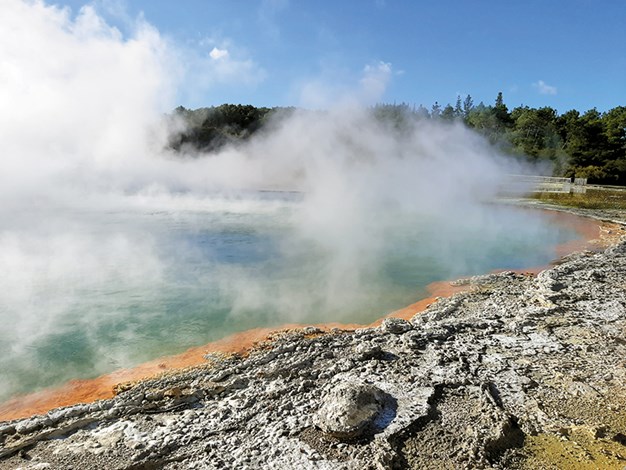 |
The Champagne Pool |
A Thermal Wonderland
The rainclouds lifted, so the following day we visited Wai-O-Tapu, a colour-splashed and diverse geothermal area south of Rotorua on the Thermal Explorer Highway. Wai-O-Tapu is part of a scenic reserve covering 18 sq km. We were too late in the day to see the Lady Knox Geyser in action, but enjoyed a leisurely 90-minute stroll around boiling mud pools, steaming vents and collapsed craters.
A highlight was the red-fringed Champagne Pool, the largest hot pool in New Zealand. It’s 62 metres deep, 65 metres in diameter and has a temperature of 74°C. Bubbles of carbon dioxide rising from the depths cause the champagne-like effect. Billowing steam made photography hard but gave the area an otherworldly feel. Beside the Champagne Pool there are 1.5 hectares of ‘sinter’ terraces, formed when water from the Champagne Pool evaporates. This has been happening for the past 700 years and the terraces are constantly growing and expanding.
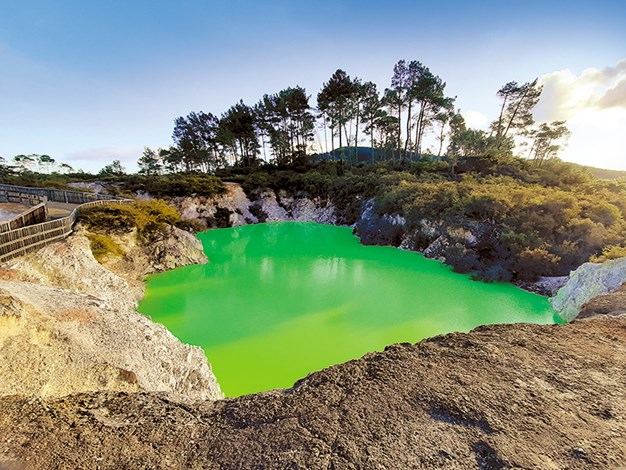 |
Suspended minerals paint this pool green |
At the Lakefront
A short walk along Rotorua’s tranquil lakefront area took us to Ohinemutu, a Maori village rich in culture. The village was the main centre of Rotorua in the 1870s, when visitors came to ‘take the waters’ and visit the pink and white terraces at Lake Tarawera.
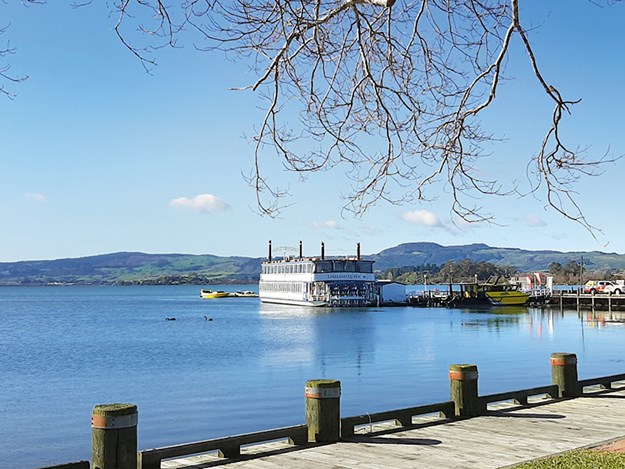 |
Rotorua lakefront |
The meeting house, Tama-te-Kapua, is named after the captain of the Te Arawa canoe. Both the exterior and interior of the meeting house are ornately carved, and there are other carvings nearby. Wandering around gave us a real sense of history, though Ohinemutu is no museum: it’s a living village.
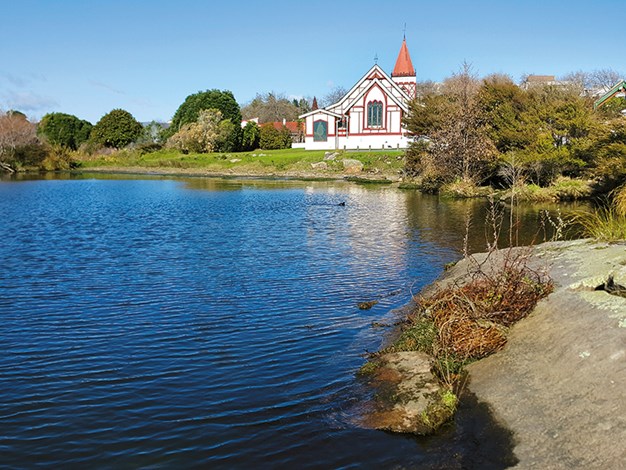 |
St Faith’s Church is worth a visit for its unique stained glass |
St Faith’s Church, opposite the meeting house, is the second church to be built on this site – the first was in 1885. The present church was built in 1914 and extended in 1967. We’ve previously been able to look around inside, but now this is only possible by arrangement (or during services). The church is well worth visiting – the interior is decorated with tukutuku panels, Maori carvings and stained glass windows. One window is unique: it features Christ wearing a Maori cloak and appearing to walk on the waters of the lake outside.
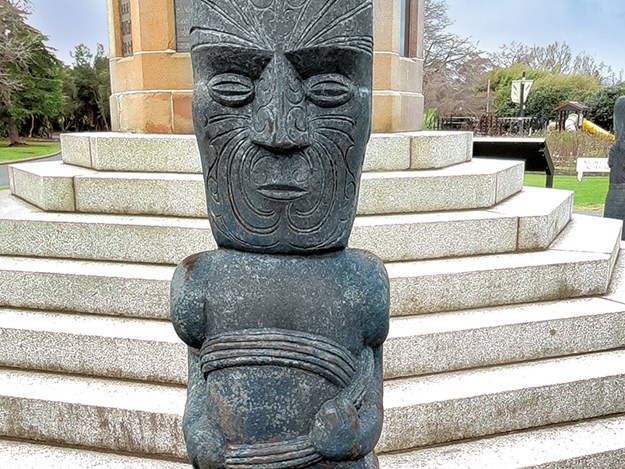 |
A Maori carving in Ohinemutu, once the main centre of Rotorua |
Behind St Faith’s Church is an interesting cemetery and memorial area, containing the graves of soldiers from the 28th Maori Battalion. The graves are raised because of the thermal nature of the ground.
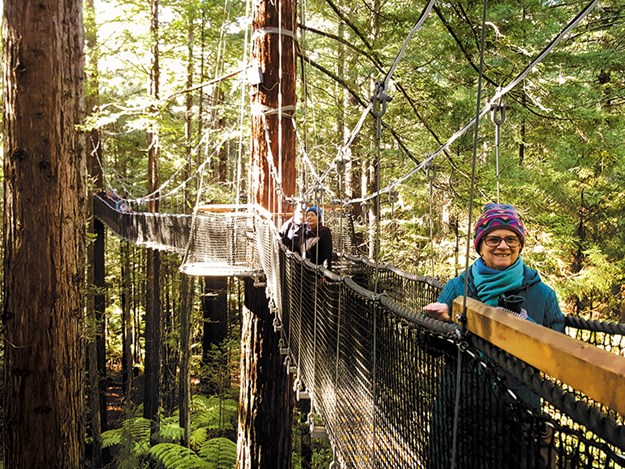 |
On the Redwoods walkway |
A Bird's Eye View
Rotorua’s redwoods were planted in the Whakarewarewa Forest at the start of the 20th century, and the trees are now giants, over 70 metres tall. The Redwoods Treewalk was on our bucket list, so we headed into the forest to experience it. A spiralling ramp took us high above the forest floor, and then we made our way across 28 swing bridges and onto platforms around the trees.
The walk took around 40 minutes; we looked down at the silver ferns on the forest floor below, and gazed up into the branches of the mighty trees above us. This was a unique experience – a chance to view a forest from a bird’s eye perspective.
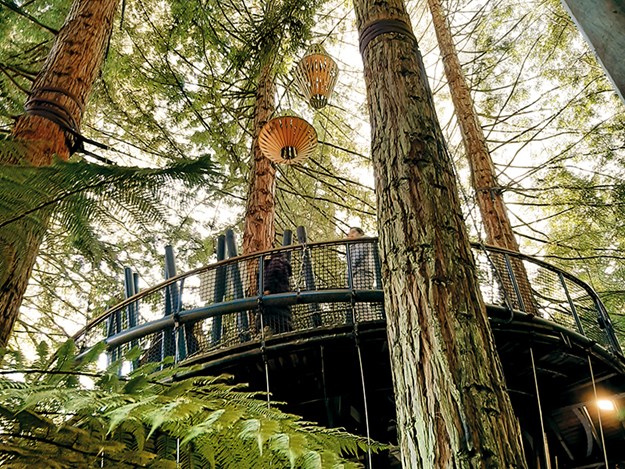 |
The Treewalk ramp takes you high above the forest floor |
The admission ticket allowed us to also visit the Treewalk at night, with lights being turned on at dusk. We decided to return in the evening but were amazed to see a huge number of people waiting their turn. The whole area was such a magical scene we voted not to queue, but to look around from the paths below instead.
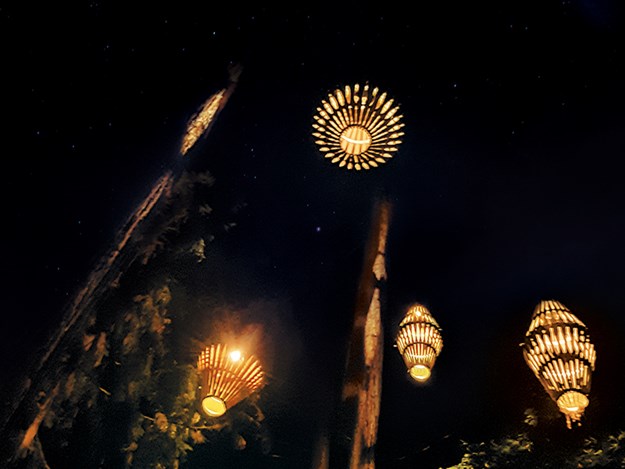 |
The Treewalk is magical lit up at night |
We had already admired the huge lanterns, designed by David Trubridge, which we’d seen during the day. At night they glowed like alien spaceships among trees and ferns that were alive with moving lights. Tree trunks and platforms shimmered with coloured lights, while mainly white ones flickered and moved at ground level. Swans flew from a huge moon projected onto the trees. It was an amazing spectacle, turning the area into an enchanted forest. We were as awe-struck as the wide-eyed children who clung to their parents’ hands. It was a fascinating end to a cold but fun-filled few days in Rotorua.
Further Information
The NZMCA has a park at Ngongotaha. There are several holiday parks in Rotorua, and freedom camping is allowed at three places. We stayed at the Hinemoa Street Carpark.
- Information about Rotorua can be found at the i-SITE on Fenton Street
- Useful websites: polynesianspa.co.nz; waiotapu.co.nz; treewalk.co.nz





